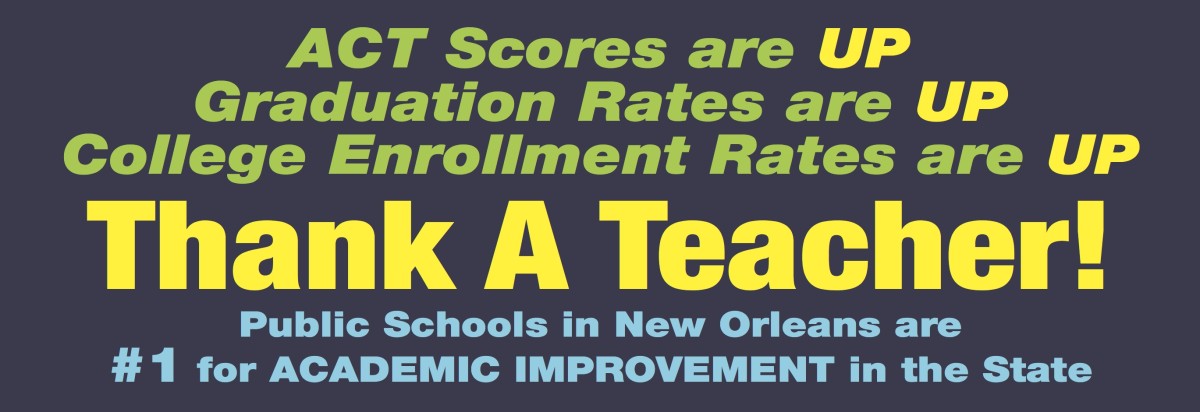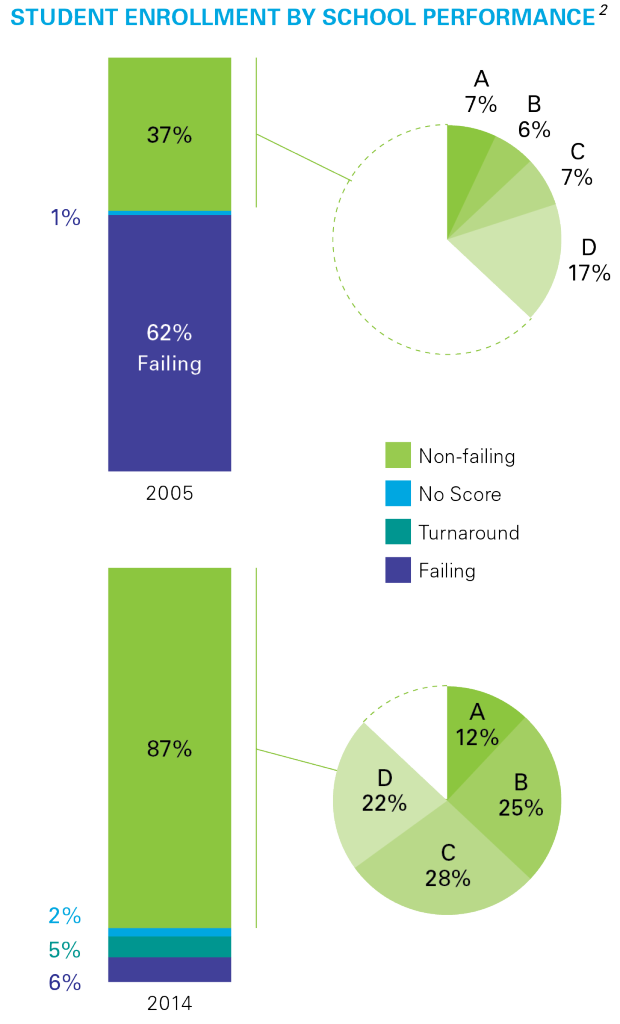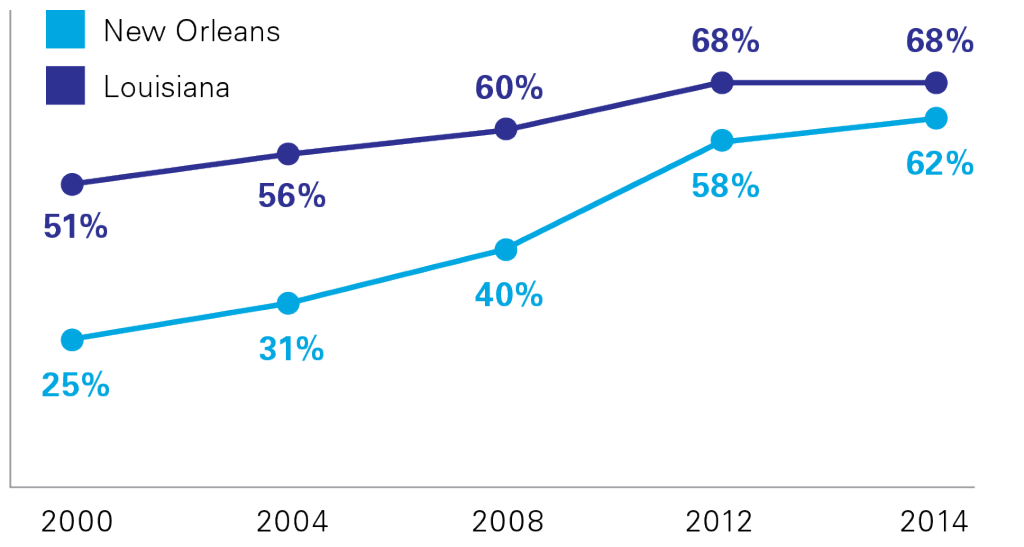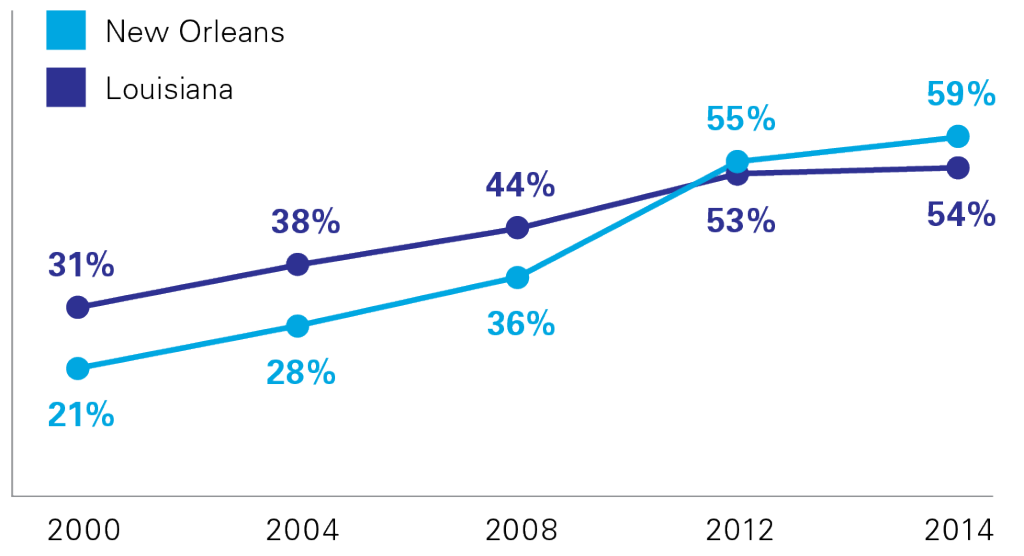Month: August 2015
National Coverage of New Orleans K-12 Education Ten Years After Katrina
The 10th Anniversary of Hurricane Katrina generated extensive national coverage of New Orleans K-12 education reforms.
Excerpt from President Obama’s speech
“Working together, we’ve transformed education in this city. Before the storm, New Orleans public schools were largely broken, leaving generations of low-income kids without a decent education. Today, thanks to parents and educators, school leaders, nonprofits, we’re seeing real gains in achievement, with new schools, more resources to retain and develop and support great teachers and principals. We have data that shows before the storm, the high school graduation rate was 54 percent. Today, it’s up to 73 percent. Before the storm, college enrollment was 37 percent. Today, it’s almost 60 percent. We still have a long way to go, but that is real progress. New Orleans is coming back better and stronger.”
Broadcast Media
Superintendent John White on MSNBC
NBC on the state of schools post Katrina
Roland Martin on Troy Simon, who could not read until age 14 and is now at senior at Bard College
The 74: Videos of Past, Present and Future of New Orleans schools
NBC highlights New Orleans education and includes the YouthRise rally
NY Magazine counters NY Times
Supt. John White is not the only one to take exception to the New York Times op-ed.
Jonathan Chait wrote a great piece for New York Magazine‘s NYMag.com called How New Orleans Proved Urban Education Reform Can Work.
And
Peter Cook provides a detailed fact check on the op-ed.
An open letter from State Supt. John White
In response to a recent New York Times op-ed that was filled with inaccuracies, State Superintendent John White has written An Open Letter to Supporters of New Orleans Schools and Children.
It’s worth the read!
By the Numbers: Student and School Performance
This fall, Louisiana’s Department of Education will release new baseline scores for schools and for student performance. As we move to the new academic standards, Educate Now! will no longer use 2005 as a comparison point. Instead, our new baseline will be the 2014-15 school year.
It’s time to focus on what’s next for New Orleans public schools, but before we move on, Educate Now! wants to thank the educators, administrators and volunteers who have worked tirelessly over the past decade to help our students succeed.
Ten years after Katrina, here’s how New Orleans public schools have changed.
SCHOOL AND STUDENT PERFORMANCE
By the Numbers: Student and School Performance
This fall, Louisiana’s Department of Education will release new baseline scores for schools and for student performance. As we move to the new academic standards, Educate Now! will no longer use 2005 as a comparison point. Instead, our new baseline will be the 2014-15 school year.
It’s time to focus on what’s next for New Orleans public schools, but before we move on, Educate Now! wants to thank the educators, administrators and volunteers who have worked tirelessly over the past decade to help our students succeed.
Ten years after Katrina, here’s how New Orleans public schools have changed.
SCHOOL AND STUDENT PERFORMANCE
By the Numbers: Student and School Performance
This fall, Louisiana’s Department of Education will release new baseline scores for schools and for student performance. As we move to the new academic standards, Educate Now! will no longer use 2005 as a comparison point. Instead, our new baseline will be the 2014-15 school year.
It’s time to focus on what’s next for New Orleans public schools, but before we move on, Educate Now! wants to thank the educators, administrators and volunteers who have worked tirelessly over the past decade to help our students succeed.
Ten years after Katrina, here’s how New Orleans public schools have changed.
SCHOOL AND STUDENT PERFORMANCE
ICYMI: Let’s Fact Check
In Case You Missed It (ICYMI) … Your mini news clippings
Fact Checking the New Orleans Reforms
Last week, Tulane University’s Education Research Alliance (ERA) published its findings on New Orleans’ student and school academic performance since Katrina. Their research showed that a typical school student’s scores rose by 8 to 15 percentage points.
“Even the lower end of that range suggests large positive effects,” ERA Director Doug Harris wrote. “We are not aware of any other districts that have made such large improvements in such a short time.”
Their analysis ruled out other factors that might have led to the improved scores.
- The gains were NOT due to changes in student population.
- The gains were NOT due to schools focusing their efforts on the “bubble students,” those right at the cusp of passing.
- The gains were NOT due to pushing students out of school. The number of expulsions, suspensions, and days suspended are either unchanged or lower than in the pre-storm period.
ICYMI: Let’s Fact Check
In Case You Missed It (ICYMI) … Your mini news clippings
Fact Checking the New Orleans Reforms
Last week, Tulane University’s Education Research Alliance (ERA) published its findings on New Orleans’ student and school academic performance since Katrina. Their research showed that a typical school student’s scores rose by 8 to 15 percentage points.
“Even the lower end of that range suggests large positive effects,” ERA Director Doug Harris wrote. “We are not aware of any other districts that have made such large improvements in such a short time.”
Their analysis ruled out other factors that might have led to the improved scores.
- The gains were NOT due to changes in student population.
- The gains were NOT due to schools focusing their efforts on the “bubble students,” those right at the cusp of passing.
- The gains were NOT due to pushing students out of school. The number of expulsions, suspensions, and days suspended are either unchanged or lower than in the pre-storm period.
ICYMI: Let’s Fact Check
In Case You Missed It (ICYMI) … Your mini news clippings
Fact Checking the New Orleans Reforms
Last week, Tulane University’s Education Research Alliance (ERA) published its findings on New Orleans’ student and school academic performance since Katrina. Their research showed that a typical school student’s scores rose by 8 to 15 percentage points.
“Even the lower end of that range suggests large positive effects,” ERA Director Doug Harris wrote. “We are not aware of any other districts that have made such large improvements in such a short time.”
Their analysis ruled out other factors that might have led to the improved scores.
- The gains were NOT due to changes in student population.
- The gains were NOT due to schools focusing their efforts on the “bubble students,” those right at the cusp of passing.
- The gains were NOT due to pushing students out of school. The number of expulsions, suspensions, and days suspended are either unchanged or lower than in the pre-storm period.




